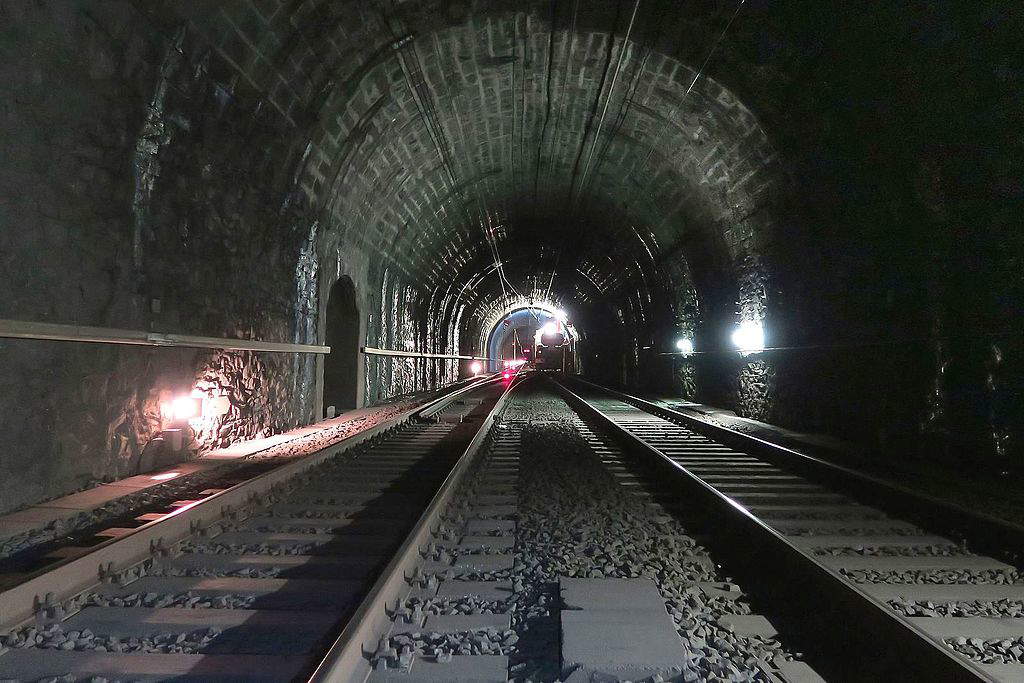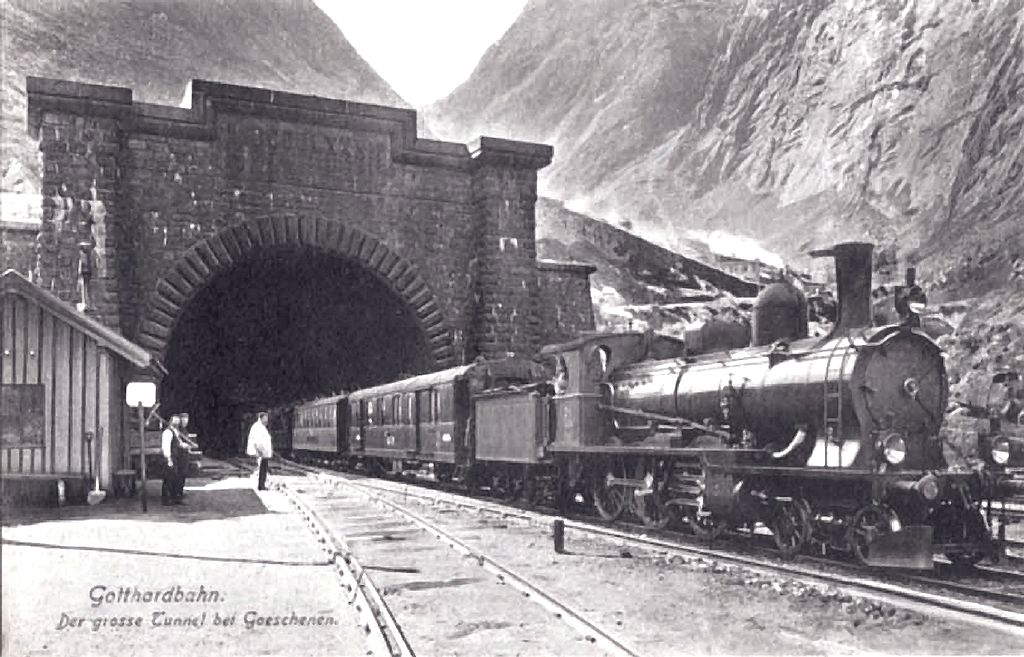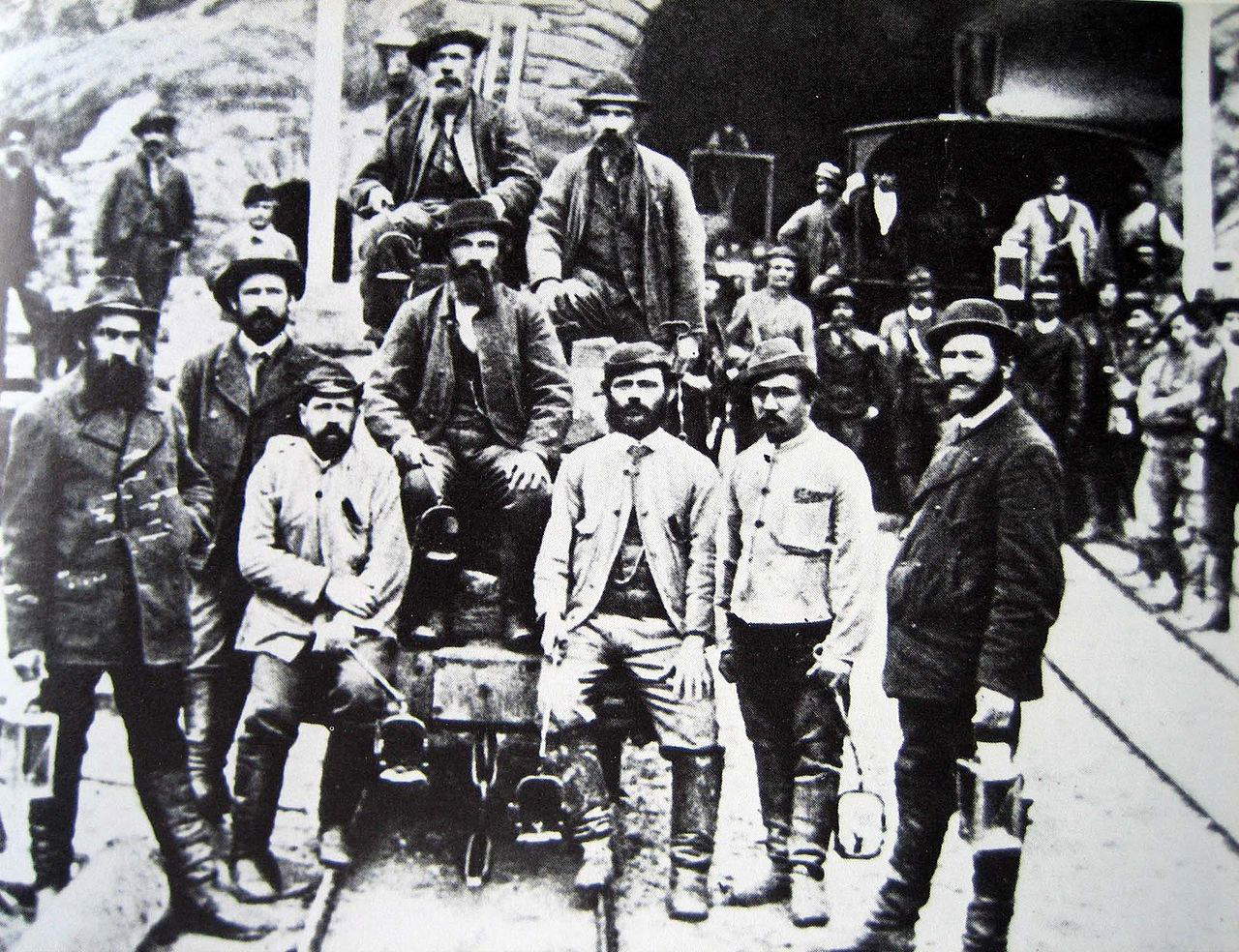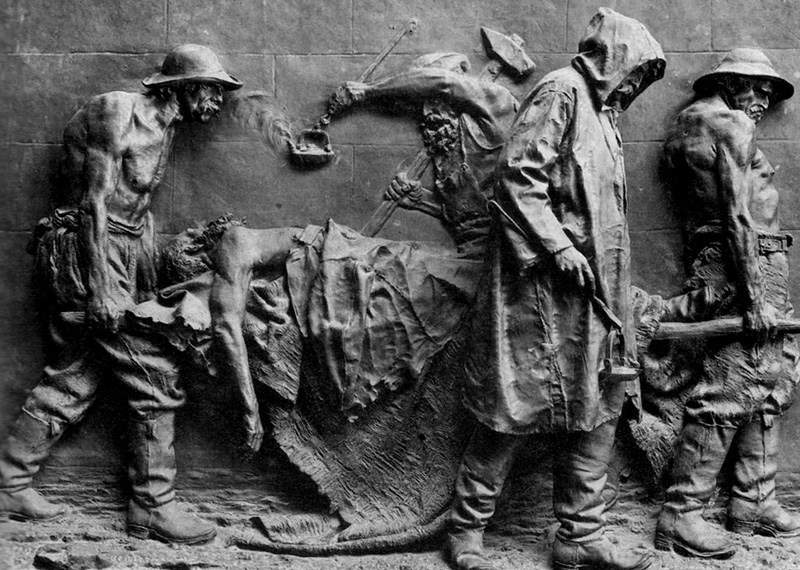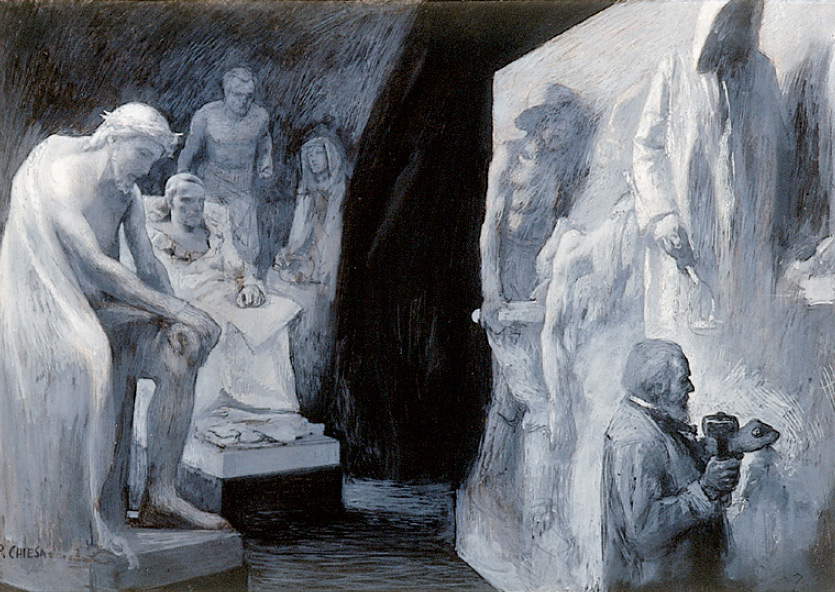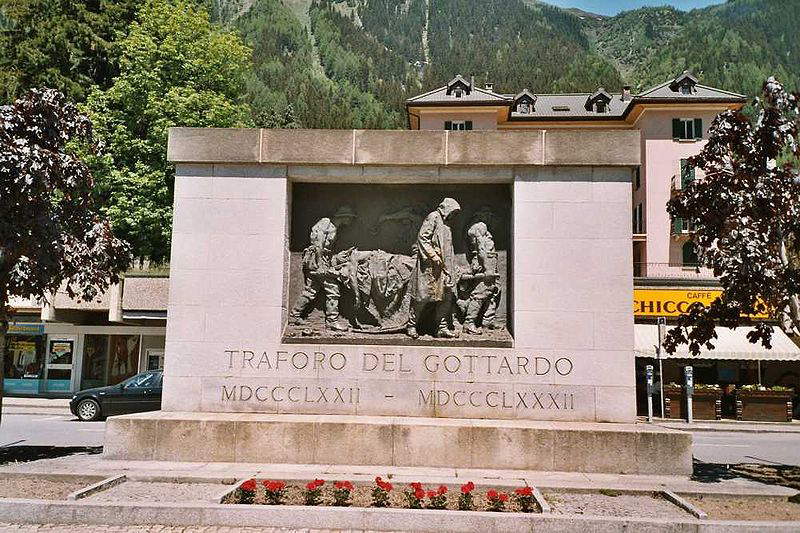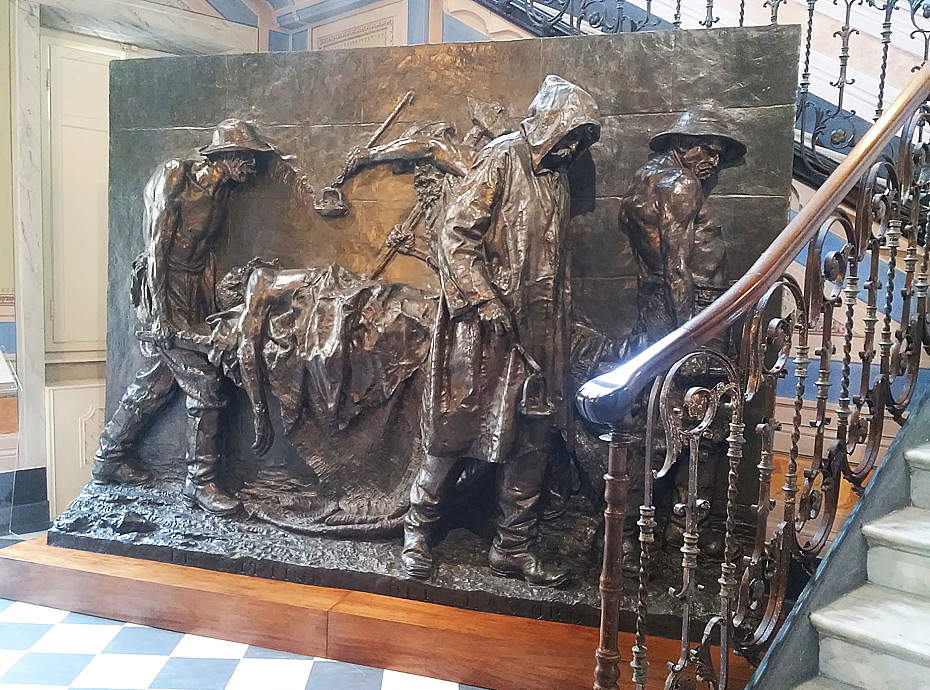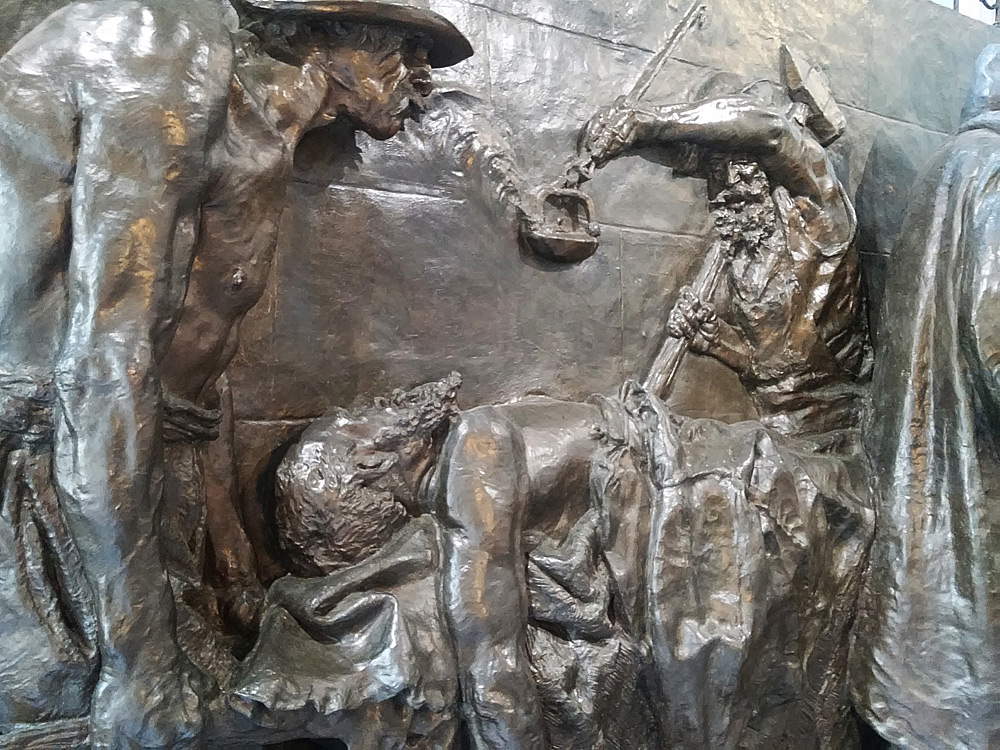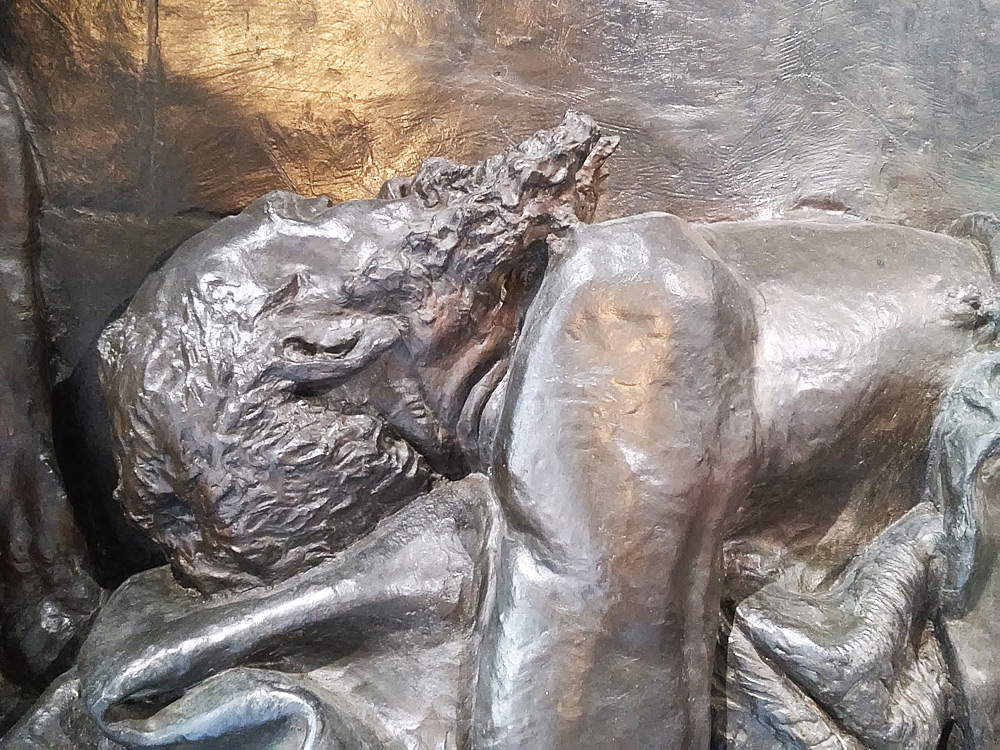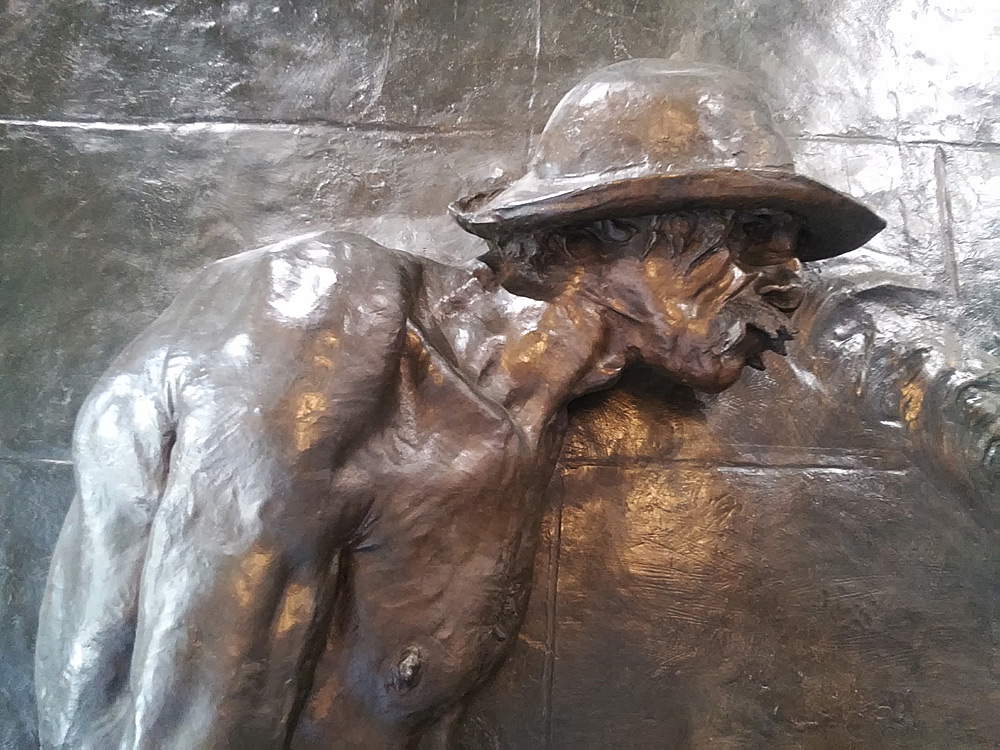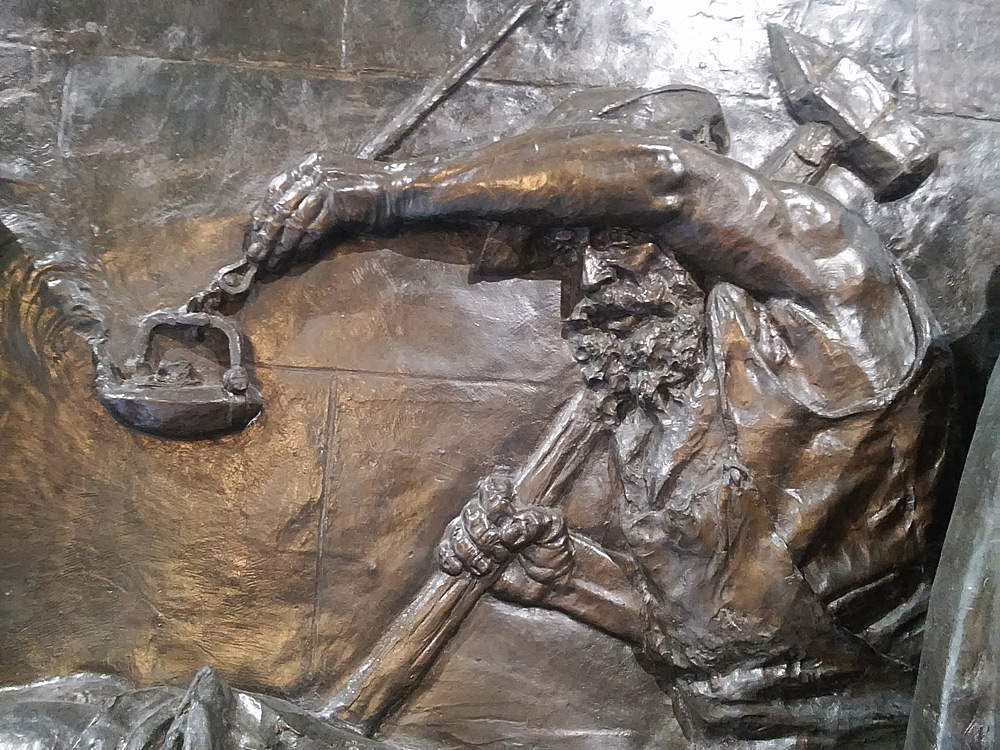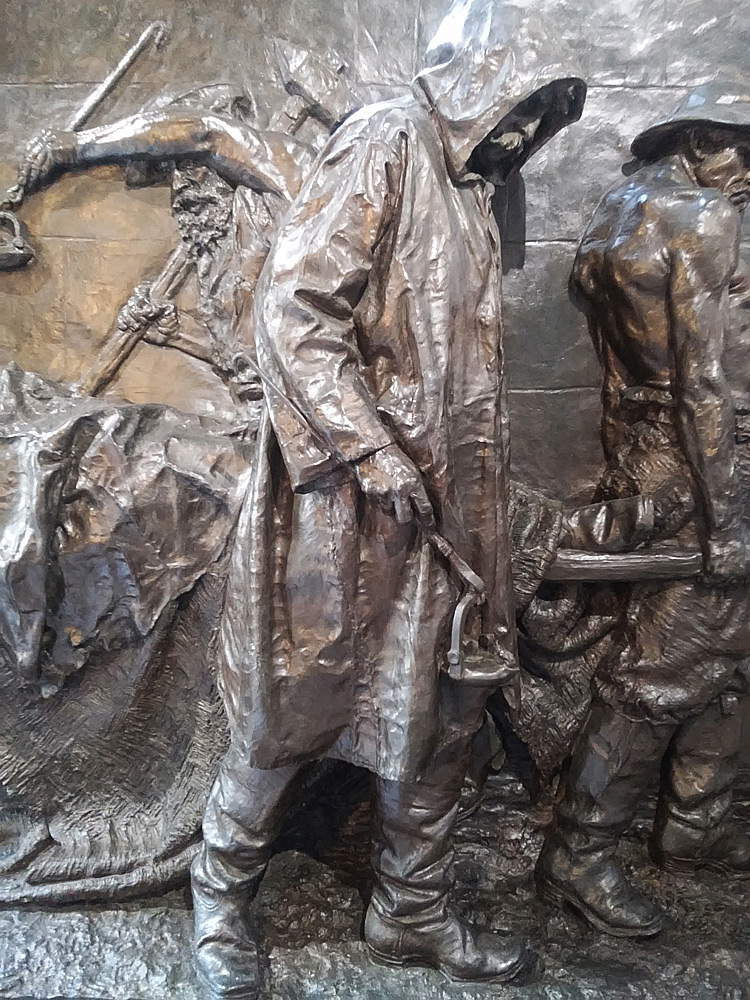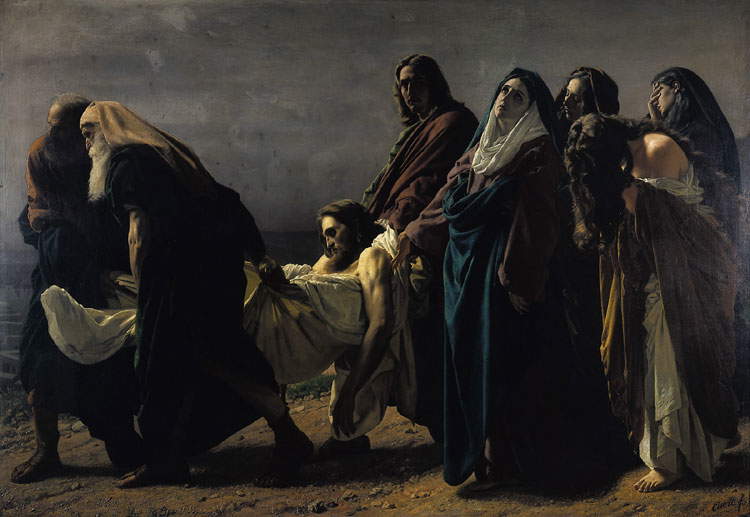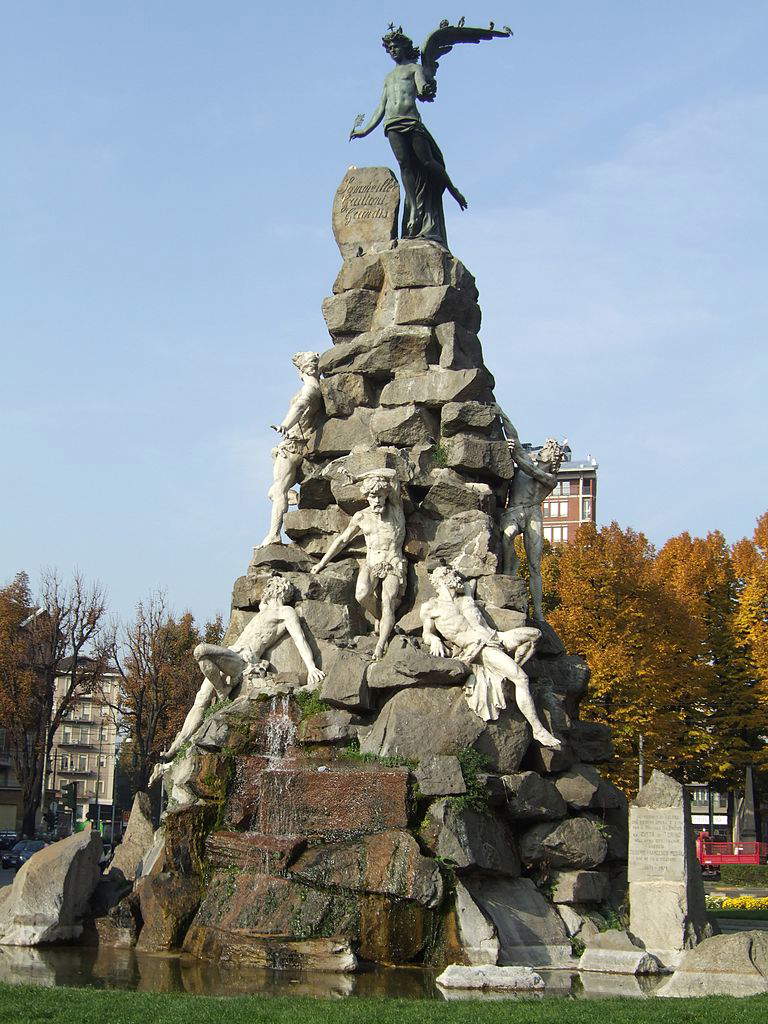by Federico Giannini, Ilaria Baratta , published on 28/07/2018
Categories: Works and artists
- Quaderni di viaggio / Disclaimer
Vincenzo Vela's monument to labor victims is one of the great masterpieces of nineteenth-century art as well as a strong and moving statement by the artist.
On May 23, 1882, the Gotthard Railway Tunnel was officially opened. It was one of the most important technological achievements of the time: it was the longest railway tunnel in the world, a fifteen-kilometer, three-meter tunnel that ran through the bowels of the Swiss mountains, under the Gotthard Pass, to unite the two boroughs of Airolo and Göschenen, the former in the canton of Ticino and the latter in the canton of Uri, enabling Switzerland to connect to the rest of Europe. The Tunnel was the result of an agreement between three countries (Switzerland, Italy and Germany) that contributed substantially to the costs: Italy and Germany, in particular, were interested in the project because the passage of a railway through the Swiss Alps would have considerably shortened the connection time between Lombardy and the industrial cities of northern Germany. Agreements between the financing states were made in 1869, and two years later the Gotthard Company, the company in charge of managing the operation administratively and financially, was established. Finally, in 1872, the work was contracted to the firm of engineer Louis Favre (Chêne-Bourg, 1826 Göschenen, 1879), the winner of the competition, who undertook to complete the undertaking in eight years. The agreement signed between Favre and the management of the Gotthard Railway, later ratified by the board of directors of the Gotthard Company and the Federal Council of Switzerland, stipulated that Fabre would be granted five thousand francs as a bonus for each day gained on the stipulated time if he delivered the work early, and vice versa a penalty of five thousand francs for each day of delay, raised to ten thousand in the case of a delay of more than six months. The Gotthard Company then reserved the right to replace Favre if the work did not progress satisfactorily.
In the end, the work would take nearly ten years to complete. Ten years, moreover, very tribulating: the work turned out to be much more difficult than expected. In addition to the technical difficulties due to the conformation of the site (and in particular to the nature of the rocks in the mountain, the composition of which often changed, forcing the engineers to have to modify the excavation and drilling techniques during the course of the work) and the economic ones (the delays greatly increased the costs of the enterprise), there were soon added problems related to the harsh conditions to which the workers were subjected. These were almost exclusively Italian workers (they made up roughly ninety-five percent of the workforce employed at the Gotthard), mostly from the poor rural areas of Piedmont and Lombardy, who were hired in large numbers by Favre to speed up the work as much as possible: in the Gotthard Tunnel they worked around the clock in three shifts, but in extreme and very difficult conditions. Every day, about eight hundred workers per shift spent eight hours in the dark and indoors, without being able to see natural light for even a minute, amid the dust and fumes caused by the machines used in the excavation work. The temperature inside the tunnel often exceeded thirty degrees, and sometimes approached forty, the scarcity of sanitary facilities caused the spread of diseases (many workers, due to the proliferation of parasites, became ill with ankylostomiasis a condition since then also known as “Gotthard anemia”), and housing was sparse and dilapidated, because Favre had been concerned only with having a residence built for technical executives and an administrative building, but had totally disregarded the miners. The latter had greatly swelled the population of Airolo and Göschenen: according to the censuses of the Swiss Confederation, the small village in German-speaking Switzerland had grown from just over three hundred inhabitants to 2,992, while Airolo doubled its residents from about 1,600 to 3,678, making it, after Lugano and Bellinzona, the third most populated municipality in the Ticino canton.
Workers housed wherever they could. Some in the few barracks built by Favre’s company: out of the more than two thousand miners who were employed in the construction of the Tunnel during the period of maximum work, only 150 lived in the “official” lodgings. The others had to content themselves with the apartments or rooms rented to them by locals. These were often far from comfortable accommodations: stables, barns, barns, large rooms where as many as a dozen people could sleep (for many workers it was enough just to have a bed). It also happened that many workers rented the same bed, spreading it out according to shifts. Still others had come to Airolo or Göschenen together with their families. And everything was done in these precarious accommodations: the lodgings served not only as dormitories, but also as kitchens, dining rooms, and laundry rooms. Most of the dwellings also lacked sanitary facilities, which encouraged the spread of further disease. There were also protests over working conditions: on July 27, 1875, in Göschenen, some workers left their workplaces in protest following an accident. They demanded better conditions, six-hour shifts instead of eight, more satisfactory wages and possibly all in cash, and not with the vouchers that could be spent in the construction company’s stores, but which the stores in the two boroughs often did not accept. Historian Alexandra Binnenkade has painstakingly reconstructed what happened on that occasion: Ernest von Stockalper (Sion, 1838 - 1919), the thirty-seven-year-old chief engineer of Favre and a man of sharp manners, sent a telegram from Göschenen to the construction management asking them to send from Altdorf, the capital of Canton Uri, fifty armed men and thirty thousand francs to meet the expenses necessary to suppress the workers’ revolt. And the revolt was brutally smothered in blood by the vigilantes, who fired on the unarmed workers (they defended themselves by throwing stones): five miners were killed, two directly by gunfire, while three died in the following days from their wounds (their names: Costantino Doselli, Giovanni Gotta, Giovanni Merlo, Salvatore Villa, Celestino Cosi). Many were injured; many others were fired.
 |
| The entrance portal of the Gotthard Tunnel from the Göschenen side. Ph. Credit |
 |
| Inside the interior of the Gotthard Tunnel. Ph. Credit |
 |
| Historical photo of the entrance to the Gotthard Tunnel on the Göschenen side (ca. 1900) |
 |
| St. Gotthard workers in Airolo (1880) |
 |
| September 1875, shots fired on striking workers at the entrance to the Gotthard Tunnel (From the magazine La ilustración española y americana, year 19, number 34, September 15, 1875. Milan, Biblioteca Ambrosiana) |
Eventually, in 1882, those killed on the job during the construction of the Gotthard Tunnel were officially counted at 177. Killed during dynamite blasts, crushed under rocks collapsing from mountain walls, run over by colleagues’ vehicles, asphyxiated by toxic fumes. Scholar Konrad Kuoni, however, revised the estimates upward by cross-referencing the data with those of insurance companies active at the time, bringing the number of those killed on the job to 199. The dead included Louis Favre himself: he was caught in cardiac arrest while surveying the Göschenen construction site and never saw the finished work (the Gotthard Company later sued Favre’s heirs because of the delay in delivering the work). But the count could be even higher if one considers how many fell ill during the work and died months or years later: it is difficult to estimate how many lost their lives from causes related to working in the tunnel. But this immense slaughter of workers did not fail to strike the sensibilities of journalists, writers and artists. Today, the best-known symbol of that tragedy is a sculpture: it is the Monument to the Victims of Labor, created by Vincenzo Vela (Ligornetto, 1820 - Mendrisio, 1891), an artist deeply troubled by the high toll of human lives that the Tunnel project had taken. Vela, born into a peasant family, was a sculptor animated by strong political ideals, actively engaged wherever he detected injustice, and deeply sensitive to the social issues of his time. In 1886, in a letter sent on November 25 to the writer Carlo Baravalle (Como, 1826 - Milan, 1900), Vela summed up the passion of his commitment in a few strong and effective words: “You know that I have never been anything but a worker: I have always boasted of it. I have always loved and admired the downtrodden poor, the martyrs of labor, who risk their lives without making the noise of the so-called war heroes and who think only of living honestly. Well, today when millions are spent to erect monuments to kings and hundreds of thousands of francs are spent to perpetuate the memory of the rich whose merit and glory lie only in their coffers, I felt it my duty to remind people at heart of these humble martyrs who are their brothers and work for everyone but themselves.”
In the letter, Vela explained the very reasons that prompted him to work on his Monument to Labor Victims. The plaster model was begun in 1880 and was ready in 1882, and the following year it was shown at theSwiss National Exhibition in Zurich under the title Die Opfer der Arbeit, “The Victims of Labor.” It was not personal glory, however, that Vincenzo Vela sought. Participation in the great exhibition in Zurich had a very specific goal: to find some financiers who could provide the resources to translate the sketch into a bronze monument to be placed in the vicinity of the Gotthard Tunnel. The plaster model met with extraordinary success: critics loudly praised Vela’s achievement, impressive for its extreme strength and the realism of its protagonists, and fellow artists, observing the power of that terrible masterpiece, were in turn inspired, so much so that some wanted to directly pay homage to the artist. For example, the young architect Augusto Guidini (Barbengo, 1853 - Milan, 1928) drew a sketch in which he imagined the monument framed by four broken railway sleepers, and some time later the painter Pietro Chiesa (Sagno, 1876 - Sorengo, 1959) depicted the sculptor intent on his plaster cast. However, despite the success he encountered, Vincenzo Vela would never see the desire to see his work translated into bronze materialize: perhaps, it was considered too upsetting and destabilizing to be shown in a public location. It was not until after Vela’s death in 1893 that the Italian Ministry of Education, in order to pay tribute to the artist, finally commissioned the Bastianelli foundry in Rome to cast the work in bronze, to be destined for what was then called the “Galleria d’Arte Moderna” in Rome and which today is instead the Galleria Nazionale d’Arte Moderna e Contemporanea, the museum where the work is still preserved. Even longer would take, however, to see the sculpture placed near the Gotthard Tunnel: the occasion was the 50th anniversary of the tunnel’s opening, which occurred in 1932. That year, the Swiss Federal Railways wished to pay tribute to the sacrifice of the many fallen for the construction of the Tunnel by taking up Vincenzo Vela’s design again. The work was again translated into bronze and placed in the Airolo station: thus the sculptor’s dream was realized.
 |
| Vincenzo Vela, Monument to the Victims of Labor (1882, cast 1895; bronze, 239 x 323 x 40 cm; Rome, Galleria Nazionale dArte Moderna e Contemporanea) |
 |
| Vincenzo Vela, Monument to the Victims of Labor (1882; plaster, original model, 255 x 332.5 x 66 cm; Ligornetto, Museo Vincenzo Vela) |
 |
| Pietro Chiesa, Vincenzo Vela grappling with the Victims of Labor watched over by his masterpieces (before 1906; mixed media on paper, 420 x 605 mm; Ligornetto, Museo Vincenzo Vela) |
 |
| Augusto Guidini (attributed to), Project for the frame of the Victims of Labor (pencil and watercolor on paper, 616 x 558 mm; Ligornetto, Museo Vincenzo Vela) |
 |
| Vincenzo Vela, Monument to Labor Victims (1882, cast 1932; bronze; Airolo, railway station square). Ph. Credit Markus Schweiss |
Vela had created the work on his own initiative, and at his own expense. There was no client, nor had anyone suggested the idea to him, as he himself wrote to Baravalle in the aforementioned letter: the artist had been incited solely by his own feeling. And to pay homage to the victims of the Gotthard, Vela chose an intense, touching, tremendously tragic moment: the carrying of a dead worker, by four of his companions. The body is lying on a stretcher and covered in the best way possible, but not enough to prevent us from seeing the head lying down and the right arm dangling in the void, like an inanimate object: the eye of the viewer focuses on that detail and sees the rough hand of the worker, marked by fatigue and years of work, become itself the most obvious symbol of the human drama that the characters are experiencing and to which we are witnessing. A drama that, moreover, is made universal by Vela’s verismo, exaggerated to the point of touching almost expressionistic heights, especially if we observe the anatomies of the workers, their backs curved to the point of improbability, their grim and tried gazes, or the disturbing figure of the hooded man, almost a sort of mournful officiant. We must then imagine the scene in the dark of night, a detail that heightens the sense of tragedy: the hooded man and the one in the background are in fact holding up a lantern to light the way for their colleagues. The same figure in the background is also depicted with a heavy mace in his right hand: an obvious symbol of struggle, a sort of vindication on the part of the artist who, as mentioned above, was from a peasant family, and thus came from the proletariat. In the artist’s intentions, then, a monument to the humble, a monument to enshrine a political struggle at a time in history when, as Vela himself recalled, monuments were dedicated to rulers, certainly not to the last.
Other aspects should also be emphasized, starting with the fact that Vela’s monument transports centuries of religious painting into a profoundly secular dimension. The scholar Giulio Foletti wanted to identify in the Transport of Christ to the Sepulchre by Antonio Ciseri (Ronco sopra Ascona, 1821 - Florence, 1891), an important masterpiece of Ticino Romanticism, a precedent that allows us to grasp a certain “spiritual affinity between the two works [...]: they are two funerals, one religious the other deliberately secular that respond to the same desire to depict, through the verism of expressions, the pain of death.” And although Vela’s work is also animated by strong narrative intentions, it is necessary to note how the relief can be placed “in a late Romantic dimension both from a formal point of view (see, for example, the deliberate anti-realistic deformation of the anatomy of the miners) and from a conceptual point of view: after all, the rhythm of the scene has a sacred and symbolic dimension that annihilates the crude realism of the composition.” A sacral dimension accentuated by the features of the dead worker, whose face, framed by a beard and long hair, recalls that of Christ: the Monument to Labor Victims thus becomes a kind of secular deposition. In the catalog of the exhibition Colori e forme del lavoro (in Carrara, Palazzo Cucchiari, from June 16 to October 21, 2018), curator Ettore Spalletti recalled how scholar Rossana Bossaglia, on the occasion of a major exhibition held in Milan in 1979(Arte e socialità in Italia dal Realismo al Simbolismo, 1865-1915), had emphasized the strongly committed character of Vela’s work, contrasting it with the celebratory character of other works that, in the same years, dealt with the theme of labor. In Bossaglia’s vision, Spalletti explained, “social painting was that which intended to take as its fundamental subject the conditions of the working classes and the humble strata of society, denouncing their abuses, and consequently was the bearer of social-humanitarian, reformist or anarchist thought.” Quite distinct from social art, it was “the celebratory art of labor as social progress that, especially since the 1990s, began to emerge in the national art scene.” The most obvious juxtaposition, also because of thematic affinity, is that between Vela’s work and the Monument to the Fallen of the Fréjus Tunnel, conceived in 1879 by Senator Marcello Panissera di Veglio (Turin, 1830 - Rome, 1886), created by sculptor Luigi Belli (Turin, 1848 - 1919) and today placed in Turin’s Piazza Statuto. The clash between the rhetoric of Belli’s monument, and the emotion of Vela’s, which in a way anticipated Pellizza da Volpedo’s very famous Quarto stato, seems evident.
 |
| Vincenzo Vela’s Monument to the Victims of Labor on display in Carrara |
 |
| Vincenzo Vela, Monument to the Victims of Labor, transport detail |
 |
| Vincenzo Vela, Monument to labor victims, the dead worker |
 |
| Vincenzo Vela, Monument to labor victims, face of the dead worker |
 |
| Vincenzo Vela, Monument to labor victims, the hand of the dead worker |
 |
| Vincenzo Vela, Monument to labor victims, worker with curved back |
 |
| Vincenzo Vela, Monument to labor victims, the worker with mace and oil lamp |
 |
| Vincenzo Vela, Monument to labor victims, the hooded worker |
 |
| Vincenzo Vela, Monument to labor victims, one of the two workers carrying the stretcher |
 |
| Antonio Ciseri, Transporting Christ to the Sepulcher (1864-1870; oil on canvas, 190 x 273 cm; Orselina, Sanctuary of the Madonna del Sasso) |
 |
| Luigi Belli, Monument to the Fallen of the Fréjus Tunnel (1879; Turin, Piazza Statuto) |
We could, without any hazard, point to Vincenzo Vela’s Monument to the Victims of Labor as one of the founding moments of our history, an important milestone on the long road of social achievements, a work of urgent topicality, since people still die of labor today. INAIL statistics found that in 2017, after years of decline, the number of work-related deaths rose again: in any case, a total of more than ten thousand workers lost their lives while carrying out their activities in the last decade. Consequently, Vincenzo Vela’s sculpture is a work that should still be reflected upon today, a work that has never lost its value and, indeed, is enriched with the passage of time: suffice it to say that a further replica was made in 2008 for the INAIL headquarters in Rome.
A significant work that continues to move. A work linked to a precise episode in European history, but which takes on a value that transcends all epochs. This was well recalled by art historian (as well as director of the Vincenzo Vela Museum in Ligornetto, Switzerland) Gianna Mina, in a contribution published in a 2016 volume dedicated precisely to sculpture: “if it is true that the value of unopera darte is also measured through its ability to express universal values deferrable in time and landed to the present day while maintaining loriginal intensity (passed unscathed through rhetorical or sentimental excesses), then laltorilievo di Vincenzo Vela [....] can be defined as a universal and inescapable work of art, to which the many news images that daily narrate of sacrifices and victims are linked.”
Reference bibliography
- Ettore Spalletti, Massimo Bertozzi (eds.), Colors and Forms of Work. From Signorini and Fattori to Pellizza da Volpedo and Balla, exhibition catalog (Carrara, Palazzo Cucchiari, June 16 to October 21, 2018), Fondazione Conti, 2018
- Gianna Mina (ed.), The Victims of Labor by Vincenzo Vela 1882. Genesis and critical fortune of a masterpiece, Vincenzo Vela Museum, 2016
- Maria Garbari, Bruno Passamani (eds.), Symbols and national myths between the 19th and 20th centuries, proceedings of the conference (Trento, April 18 and 19, 1997), Società di Studi Trentini di Scienze Storiche, 1998
- Sandra Pinto, Gianna Piantoni, National Gallery of Modern Art, SACS Editions, 1997
- Alexandra Binnenkade, Sprengstoff. Der Streik der italienischen Gotthardtunnelarbeiter - Alltag und Konflikte im Eisenbahnerdorf Göschenen 1875 / Explosive Agents. The Italian tunnelworkers on strike: Everydaylife and conflicts in Göschenen 1875, Dissertation, University of Basel, 1996
- Konrad Kuoni, "Allein ganz darf man die Humanitätsfrage nicht aus den Augen verlieren. Der Bau des Gotthard-Eisenbahntunnels in wirtschaftlicher, politischer und sozialer Hinsich, Dissertation, University of Zurich, 1996
- Ugo Maffioletti, Moments of life in Airolo in the decade 1872-1882, in Cronache di vita Ticinese (1981), pp. 21 - 27
Warning: the translation into English of the original Italian article was created using automatic tools.
We undertake to review all articles, but we do not guarantee the total absence of inaccuracies in the translation due to the program. You can
find the original by clicking on the ITA button. If you find any mistake,please contact us.

